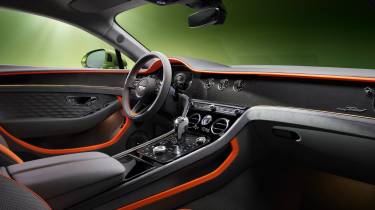New Bentley Continental GT is firm’s most powerful road car ever
New 771bhp hybrid powered Continental GT replaces the W12 and introduces a more dynamically-focused chassis.
Bentley has revealed its fourth generation of the Continental GT, the car that saw the Crewe based manufacturer go from building 414 cars in 1998 to 7,500 cars in the first full year of production in 2003. With a new ‘Ultra Performance Hybrid’ powertrain, the new GT is powered by a 771bhp 4-litre twin-turbocharged V8 and tops out at 208mph, making it not only the most powerful Bentley road car ever, but the fastest, too.
Launching in Speed trim first, the new Conti GT will only be offered with a V8 hybrid powertrain, replacing both the outgoing V8 and iconic W12 units. Producing 11 per cent more torque than the twelve cylinder motor and 19 per cent more power, the new powertrain doesn’t result in a performance drop off.
The V8 uses mono-scroll turbos and generates 591bhp and 590lb ft, and the hybrid system means it can do away with cylinder deactivation technology. Fuel pressure delivery is also increased to 350 bar from 200, and the torque range might arrive fractionally later in the rev range (the peak is between 2000 and 4500rpm) but lasts for longer than it did with the W12.
In addition to the internal combustion engine is a 25.9kWh battery, which is mounted behind the rear axle and is a contributing factor to the car’s 50:50 weight distribution. This powers a motor that lives inside the eight-speed automatic transmission generating 187bhp and 332lb ft. It's designed to provide both torque-fill at lower engine speeds as the turbos spool up as well during gear shifts to smooth the process. It also provides the Continental GT with its 50 miles of electric range, and combined with the ICE creates 771bhp and 738lb ft of torque.
It will reach 60mph in a claimed 3.1 seconds, 100mph in 6.9 and its 208mph top speed is only limited by its Pirelli P Zero tyres. It has also set an unofficial world record for the highest recorded ‘under the sea’ speed by a car, reaching 208mph in the 8.9-mile Ryfylke Tunnel in Norway.
Underpinning the new Continental GT is a host of new chassis hardware and software, including new two-chamber air suspension replacing the previous three-chamber system. Accompanying this are new two-valve dampers designed to improve body control without compromising ride quality by providing independent control of compression and rebound damping forces.
There is a new electronic rear differential, all-wheel steering, torque vectoring that works front to rear and across both axles, Bentley’s active anti-roll system and the ESC control software has been totally rewritten to suit the car’s new dynamic make-up.
A brief drive on track in a prototype demonstrated the flex of the new powertrain, which is well within itself to travel at a decent speed in electric mode with up to 75 percent throttle opening. That it is a much sharper and more responsive machine when the drive modes are wound up to Bentley and Sport mode, with a heavier straight line punch and more reactive and quicker out of slower turns – the blend between performance and efficiency is well thought out.
In terms of dynamics, it feels like a car that pivots around your mid-point, eradicating the sensation many GTs have that makes you feel there’s either a vast amount of real estate out front that requires managing or similar behind you that’s waiting to make itself felt.
The standard front brakes measure a colossal 420mm on the front, 380mm on the rear with 10 and four-piston calipers respectively. Carbon-ceramics are optional.
While the powertrain and chassis changes are significant, the design evolution is equally substantial. Out goes Bentley’s traditional twin-headlamp design and in comes a single unit with a strike light-bar running through it. There’s also a more defined and detailed front bumper unit and upright stance to the grille to give this fourth generation GT a more muscular, toned look. The detail added to the areas around the intakes are functional to direct more air more efficiently to where it’s required.
At the rear the active rear wing at the base of the window has gone, replaced with a more pronounced aerodynamic form integrated into the boot lid to reduce lift. It provides a clear ‘over lip’ at the rear of the car, but it looks more defined with the detail around the new bumper and tail lights more neatly executed.
Internally the work is less prominent and focuses on the technology within, with over the air updates and a new Bentley app that allows owners to control and monitor the car’s charging status (a full charge takes 2.75 hours on a 11kW charger), utilise remote park assist and pre-condition the car via the climate control. The My Bentley App studio has also been introduced, allowing you to store your preferred apps within the car once you have paired your device.
Making its dynamic debut at the Festival of Speed before heading Stateside for Pebble Beach in August, the new Continental GT Speed will be, for the first time, launched as both a coupe and GTC convertible.












